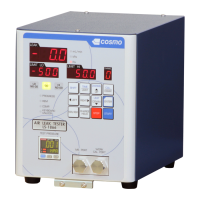28 5 INSTALLATION
5.4.3 Choosing proper connection to the tested part and the master
1) Recommended nylon tubing types
• Use of rigid nylon tubing that is less liable to expansion from pressure is recommended.
• Select a tubing type to suit the volume of the tested part and the test pressure. See the table below
for general guidelines.
• Choose tubing whose thickness is in proportional to the test pressure and inner diameter is in
proportional to the inner volume.
Part volume
20 mL
Inner diameter: 1.6 to 3.3 mm
Thickness: 0.7 to 1.6 mm
200 mL
Inner diameter: 3.2 to 3.5 mm
Thickness: 0.8 to 1.6 mm
Inner diameter: 2.4 to 3.3 mm
Thickness: 1.0 to 1.6 mm
500 mL
Inner diameter: 3.2 to 6.4 mm
Thickness: 1.2 to 1.6 mm
Inner diameter: 3.2 to 4.9 mm
Thickness: 1.5 to 2.4 mm
1000 mL
Inner diameter: 4.8 to 6.4 mm
Thickness: 1.2 to 2.4 mm
2000 mL
Inner diameter: 4.8 to 6.4 mm
Thickness: 1.2 to 2.4 mm
Inner diameter: 4.8 to 4.9 mm
Thickness: 2.3 to 2.4 mm
5000 mL
Inner diameter: 6.3 to 6.4 mm
Thickness: 1.2 to 3.2 mm
Inner diameter: 6.3 to 6.4 mm
Thickness: 3.1 to 3.2 mm
Tubing grouped by inch
Inner diameter (2.36 to 9.56 mm), thickness (0.41 to
1.57 mm)
Used in the lower test pressure range. Test
Inner diameter (1.60 to 6.40 mm), thickness (0.79 to
3.15 mm)
Used in the higher test pressure range. Test
Tubing grouped by millimeter
Inner diameter (2 to 13 mm), thickness (1.00 to 1.50)
Inner diameter (2.5 to 13 mm) , thickness (0.75 to 1.5)
2) Do not use push-on fitting but use compression fitting for small-volume parts (up to 1000 mL), because
O-ring deformation may affect tester reading. With tubing that is 1/2 inches (outer diameter 12 mm) or
larger, compression fitting may get loose over extended period of time. In such case use one-touch
fitting.
3) For a vacuum type test, larger inner diameter tubing should be used. For a high vacuum, tubing or
piping with relatively smooth inside surface should be used.
4) Keep tubing length as short as possible.
5) If Master-Preset compensation is not used the tested part and master tubing should be approximately
the same length and the same type of material.
6) Keep the tubing stationary while leak test is in progress.
If copper or steel tubing is used, cover it with a heat insulator
because it’s easily affected by temperature changes.
If the test pressures listed in the table above are exceeded, choose
from the N2 tubing group 2 (N2-2) or use a metallic material.

